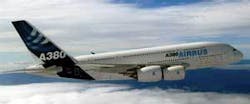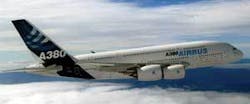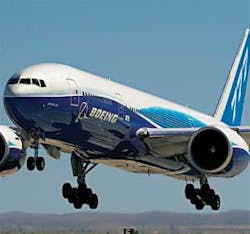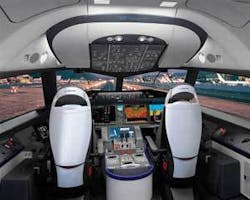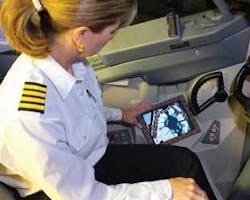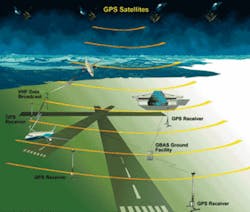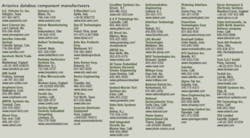The coming revolution in commercial avionics data networking
There is a new databus in town for passenger jetliners, called AFDX, which is set to replace or augment the widely installed ARINC 429 on the Airbus A380, the Boeing 787 Dreamliner, and perhaps on future generations of regional passenger jets.
By John Keller
The avionics of commercial jetliners are in the midst of a major transformation from the federated electronics of the past to the integrated architectures of the future as the venerable ARINC 429 point-to-point data link gives way to the AFDX Ethernet-based high-speed serial databus.
This transformation is just as fundamental as the change in military aviation that started in the 1970s that saw the hard-wired point-to-point avionics architectures of Vietnam-era combat aircraft give way to the integrated avionics of the MIL-STD-1553 databus on F-15 and F-16 jet fighters.
The military’s avionics evolution to 1-megabit-per-second 1553 led to today’s use of Fibre Channel and other high-speed serial databuses on the F/A-18 strike fighter, the F/A-22 fighter-bomber, and the future F-35 Joint Strike Fighter. AFDX is expected to lead to new avionics architectures just as profound.
The AFDX databus, short for Avionics Full Duplex Switched Ethernet, also is known as ARINC 664. This bus has the capability to move data over copper wire or optical fiber as fast as 100 megabits per second-or 1,000 times faster than ARINC 429. Plans are in the works to speed the Ethernet-based AFDX to 1 gigabit per second over the next several years.
“AFDX is a specialized Ethernet protocol that is designed to run on aircraft,” explains Todd Decker, marketing manager for databus products at DDC Corp. in Bohemia, N.Y. “It is 10/100 Ethernet with protocols built in to enhance reliability.”
This networking progression of commercial avionics has the potential to enable a growing number of data-intensive applications on future jetliners, drastically reduce the amount of heavy copper wiring, and may usher in a new era of fiber optics for networking data on tomorrow’s commercial passenger aircraft.
ARINC 429
The first major change in avionics databusing on commercial aircraft came in the 1970s and ’80s in the form of the 100-kilobit-per-second ARINC 429, a multiplex digital databus standard of ARINC Inc. in Annapolis, Md., formerly known as Aeronautical Radio Inc.
The databus is ubiquitous on commercial airliners-perhaps one of the most common avionics components flying today. “The ARINC 429 is on all commercial airplanes, for legacy connections and to secure backup for FAA flight-critical controls,” explains Richard Schuh, avionics product line manager at GE Fanuc Embedded Systems (formerly Condor Engineering) in Santa Barbara, Calif.
“ARINC 429 is still the de-facto standard,” says Kevin Christian, customer services manager at ARINC 429 supplier Ballard Technology Inc. in Everett, Wash. “It is used on the airplane for digital electronics, air data computers, navigation computers, radios, and engine control systems that are all computerized and need to talk to each other.”
ARINC 429 is largely responsible for launching the digital era in commercial avionics. It is a relatively slow serial twisted-pair broadcast databus that is not bidirectional like 1553 and its more recent cousins. Only one terminal on the bus can transmit, and as many as 20 terminals can listen.
“ARINC 429 introduced digital data transfer on commercial airliners, and is first-generation bus technology,” explains Paul Prisaznuk, senior principal engineer at ARINC in Annapolis, Md. “The 429 represents a strictly federated architecture with standard K-sized ARINC connectors. You really don’t get into integrated architectures with 429.”
Before the ARINC 429, Prisaznuk explains, avionics designers used hard-wired point-to-pint connects with analog signals for every sensor type, such as navigation gyros. “Some sensors had multiple signals and multiple wires,” he says. “You had lots of analog wires and dedicated systems. That’s the way the early avionics was done.”
In typical applications on today’s jetliners, systems designers use ARINC 429 to connect avionics subsystem boxes digitally. One master subsystem on the bus can send information to as many as 20 slave subsystems, but the slaves cannot send data back to the master.
For a slave subsystem to send information back to the master, designers simply use another ARINC 429 bus and reverse its direction, enabling the original master to listen and the original slave to transmit.
Often designers use two ARINC 429 buses as what amounts to point-to-point bi-directional interconnects between avionics subsystems-one bus that transmits in one direction, and another bus that transmits in the other direction.
One example of this involves the jetliner’s flight-management computer, which processes signals from a wide variety of sensors and other subsystems and to calculate flight paths, fuel burn, time of arrival, and other tasks.
In this approach, ARINC 429 buses transmit data from the sensors, and enable the flight-management computer to listen to the data. When the flight-management computer must send information tack to a sensor, designers use another 429 bus running in the opposite direction.
Despite its slow speed, the digital ARINC 429 databus helps increase efficiency, speed, and ease of maintenance, as it can move many different digital data packages over the same twisted pair; analog approaches often required a different wire for every signal.
“If we were back in the old analog world, we might need a separate wire for every sensor parameter, and we would become very wiring intensive,” Prisaznuk explains. “The digital 429 bus allows you to multiplex the information on just two wires.”
Since the ARINC 429 databus moves data in only one direction, it is extremely reliable because of its low probability of data conflicts or data corruption. Its reliability makes the databus popular even today for flight-critical data involving avionics tasks such as engine control and navigation.
Also driving the ARINC 429’s popularity is the sheer size of its installed base; it is part of almost every commercial jetliner manufactured over the last quarter century.
“ARINC 429 has limited bandwidth and limited addressing capability, yet is a highly robust physical bus and as such has really served the industry very well for a number of years; it is still used extensively across the industry,” explains Nick Bloom, principal engineering manager for systems architectures at avionics designer Rockwell Collins in Cedar Rapids, Iowa.
“For those installations where you need limited bandwidth and don’t need extensive address space on the bus, it is still a very viable bus and protocol,” Bloom says. We still have a large number of products that leverage the ARINC 429 standard, and in many cases we may look at it as a legacy bus. It historically is a very robust bus architecture.”
Modern avionics architectures, however, often need more bandwidth than the ARINC 429 can deliver.
“As we’ve driven avionics systems to higher levels of integration, we found there is a corresponding need for higher bandwidth requirements, more address space, and more flexibility in the data that is placed across a particular bus,” Bloom says.
The evolution in commercial avionics databuses has not proceeded smoothly from ARINC 429 to AFDX. In fact, there was an interim step along the way that avionics designers once thought represented the next generation of avionics networking.
ARINC 629
This databus was called ARINC 629, a 2-megabit-per-second databus that in some ways spun off from MIL-STD-1553 technology. “The transition to an ARINC 629-type of bus topology really supported the move within the aviation community to higher levels of integration within the full systems across the avionics and the aircraft systems,” Bloom says.
The launch of ARINC 629 was on the advanced avionics architecture of the Boeing 777 twin-engine jumbo jetliner. When the databus was unveiled, industry experts believed it represented the future of commercial avionics. It started life as a Boeing invention called DATAC, short for Digital Autonomous Terminal Access Communications.
Compared to 429, “ARINC 629 is a different beast altogether,” explains ARINC’s Prisaznuk. “629 is bi-directional, and eliminates the master, which is a potential single point of failure. It’s a pretty sporty technology, but it’s not cheap.”
ARINC 629 is far more akin to 1553 than is ARINC 429, “in that we have bidirectional flow of data,” says Ballard’s Christian. “Units can transmit and receive, and is a lot faster.”
Bus efficiency, or the ratio of actual data the bus carries versus routing overhead code, also was an attractive aspect of ARINC 629. “ARINC 429 has an efficiency of 45 percent, but with 629 efficiency can approach 85 percent if you architect the bus right,” Prisaznuk says.
“What was cool about it, compared to 429, is it was to be a bus without connectors,” explains DDC’s Decker. “ARINC 629 took the approach where you would take a twisted pair of wires and feed it through bus coupler that acted like a transformer.”
It was the price, however, that gave designers second thoughts about ARINC 629. It was supposed to increase reliability, but it turned out to be a lot more expensive than they thought,” Decker says.
Cost concerns, a relative lack of large new commercial aircraft projects around the time Boeing developed the 777, and the emerging popularity of Ethernet networking technology combined to halt ARINC 629 implementation after the 777. “It was somewhat of a dead end,” Ballard’s Christian says. “629 is expensive and heavy to implement. It is not going anywhere because of ARINC 664.”
ARINC 664 AFDX
Fast forward about a decade beyond the 777’s development. European jetliner designer Airbus had the A380 super-jumbo jet on the drawing board, and Boeing was looking at a composite aircraft structural commercial jet technology that evolved into the future 787 Dreamliner.
Neither company wanted the expense of the ARINC 629 bus, and saw the growing popularity and installed base of Ethernet. The result was AFDX, which also became ARINC 664. “In our view Ethernet will rule everything,” says GE Fanuc’s Schuh.
Airbus is implementing copper AFDX databuses on the A380, and Boeing will implement AFDX over optical fiber on the 787 Dreamliner.
“AFDX is a virtual 429,” Schuh says. “In a lot of the data they have taken 429 data into AFDX Ethernet packets and put it on a switch. In some regards it is a strange non-technical implementation because in its simplest form it is simply 429 on Ethernet. It is not so much a migration path as a leap to a network-based star configuration network.”
One consistent knock against Ethernet for mission- and life-critical applications like aircraft avionics is Ethernet’s difficulty with determinism-or the ability to predict accurately how long message traffic takes to pass through the network under all manner of conditions.
“Ethernet is non-deterministic in a normal office environment,” Schuh explains. “You don’t care if it takes 500 or 700 milliseconds to get that document from your computer to your printer, but switched Ethernet can be deterministic if you do the math to determine if your ports and switches don’t exceed the bandwidth. It can be deterministic to a point.”
AFDX designers painstakingly compiled a log of how long message traffic takes to pass through the network under a wide variety of operational scenarios. “AFDX builds gigantic database and they make sure not to exceed bandwidths that exceed their dependencies for determinism,” Schuh says. “There’s nothing magic about it; you sit down with a spreadsheet to do the math for the worst-case scenarios to see if the worst possible delay is acceptable. That is determinism.”
The industry has begun to rally round AFDX such that many experts believe it is here to stay. “AFDX will represent a strong merchant board business in next year to 18 months because Boeing is throwing money at the 787,” Schuh says. “Then we will see a tail-off on it because the regional jet guys don’t spend money like the big commercial guys will.”
Other companies also are betting on the new databus. “AFDX has a significant amount of staying power,” says Ken O’Neill, director of military and aerospace product marketing at Actel Corp. in Mountain View, Calif.
Actel specializes in field programmable gate arrays (FPGAs), and provides ARINC 429 and AFDX interface hardware implemented in FPGAs for avionics designers like Rockwell Collins and Smiths Industries in Grand Rapids, Mich.
“We recently were requested to add 50-kilobit-per-second ARINC 429 to our cores,” says Rich Woener, senior product marketing manager of IP Solutions at Actel. “We have a core 429 offering that supports legacy chips and implements new features to offer AFDX solution, but do not have it on the shelf yet.”
Such an approach that implements ARINC 429 and AFDX protocols on the same device undoubtedly will come in handy in future aircraft designs and perhaps in some avionics upgrades. Although ARINC 429 has seen its best days, it will still be part of future aircraft architectures where it makes sense.
Where simple point-to-point interconnects are necessary, ARINC 429 may be the answer. ARINC 429 will be used together with early implementations of AFDX to back up flight-critical systems such as engine control and navigation, as well as to interface with legacy 429 systems.
null
